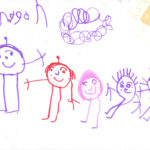
Despite all of the policies and guidelines exhorting family or carer involvement in mental health care, and the evidence that many families wish to have more involvement, in reality families are rarely involved when people are admitted to acute mental health care. The pressure on resources and time means that contacting family members to see if they can attend meetings or ward rounds is likely to fall low down the list of priorities.
The authors of a recent paper in BMJ Open point to the strong focus on risk reduction and crisis management as a barrier to family involvement (Dirik et al, 2017). They are also concerned about the reason for involving families, since families can be both seen as a cause of the problem as well as being expected to provide support.
This paper is addressing more structured approaches to family involvement than the idea of simply involving families in routine acute care. The authors sought to explore different ‘family involvement models’ and to look at the theories underlying the models to see if there might be a relationship between these and the extent to which the models are implemented in practice. They were also concerned to understand the nature of service user and carer involvement within the different models.
The paper explores the following questions:
- Which family involvement models are used in general adult acute mental health settings?
- What is the theory or rationale underlying family involvement models?
- What are the components of the models?
- What is the role of patients and family in the delivery of the models?

Families are rarely involved in a meaningful way when people are admitted to acute mental health care.
Methods
The authors used a conceptual review methodology. This entailed a systematic search of electronic databases for papers describing models where the primary focus was to ‘involve family members in order to support the patient’s care in acute settings’. In other words, the models selected describe active rather than passive support. They included papers across the English speaking world and those translated into English.
One of the key elements of the methods used was to include service user researchers alongside academics and clinicians in the review team. The team report that this enabled a deeper understanding of the concepts in each model and the identification of potential harms or problems in the models.
Following the searches, the team then carried out a narrative synthesis of the resulting papers to cluster them into categories of family involvement models. The theoretical basis for each of the models was fully analysed with reference to a wider team of 30 researchers, an expert in Family Intervention, two service user groups with experience of research and a Social Psychiatry expert academics meeting.
Results
The models
The team identified six distinct family involvement models from 16 key sources:
- Calgary Family Assessment and Intervention Models (Canada)
- ERIC (Equipe Rapide d’Intervention de Crise) (France)
- Family psychoeducation models (UK, USA)
- Family Systems Approach, SYMPA (systems therapy methods in acute psychiatry) (Germany)
- Open Dialogue (Finland)
- Somerset Model (UK)
Underlying theories
Having identified these six models, the team then explored how they related to their theoretical influences; these included: systems theory, the diathesis-stress model and post-modern theories. There were some overlaps in the ways in which these influenced the models and they give a diagram to demonstrate this.
Components
The analysis revealed a number of components, the focus on each of which varied across the different models. The components identified were:
- Communication/language use
- Joint decision-making and the role of experts
- Support for the family themselves
- Wider social network involvement
- Medication use
- System organisation
Some of these components were common across the models; for example, communication and language use was emphasised in different ways by all models. Similarly, there was some emphasis on joint decision-making in all of the models, although the models based on post-modern theories (such as Open Dialogue) minimised the role of professionals in treatment decisions. Medication use featured in all of the models to different extents. Some of the diathesis-stress models focus on educating the family to support medication adherence, but in Open Dialogue, by contrast, medication is used minimally. An area of major difference was ‘system organisation’. Models based on the diathesis-stress theory involved training a small group of staff specialists, whereas the systemic models require whole teams to be trained in family involvement principles.
Involvement of patients and families
A thematic analysis of papers in relation to the role of patients and families within the different models resulted in the following themes:
- Families as a resource
- Linear roles and relationships
- There is a ‘patient’ and a ‘carer’
- Families want to help
- Family involvement is always beneficial
- Risk of identity loss
- Implementation versus choice
These themes raise some interesting issues, particularly in connection with assumed roles and questions of choice. It seemed not always clear whether patients and families were able to exercise choice about family involvement, and there appeared to be an assumption in many papers that family involvement would necessarily be a good thing. This runs the risk of overlooking the potential harm and abuse in some families. In some circumstances, where there is a whole system approach towards family involvement, there might not be much choice for the individual patient who may not want their family or extended network involved in something they wished to remain private.

The assumption that family involvement is a good thing may run the risk of overlooking the potential harm and abuse in some families.
Conclusions
The authors conclude that there are many commonalities across the different models for family involvement they identified. There are some organisational or structural reasons for the more successful implementation of some models in practice; for example, the psychoeducation models fit more easily into a service based broadly on a biopsychosocial medical model for understanding mental distress. Conversely, the Open Dialogue model might struggle for acceptance in such a service.
The review highlighted the importance of choice for both service users and family members, particularly where there is system-wide implementation of a family involvement model, rendering individual dissenting voices potentially unheard. Finally, the authors encourage:
further discussion of the differences and similarities between the various models and theories, taking into consideration different ideas about the nature of mental health and the purpose of involving families in these contexts (p.9).
Strengths and limitations
A key strength of this paper was the collaborative approach taken to the analysis, involving service users as active members of the team. It is also good to see the authors report on the difference that this made, as too often research papers do not report on the nature of the contribution made by service user involvement to a study. The coverage of papers is clear and international within a Western mental health context. The authors have also reported their analytic process in some detail which enables the reader to follow their thinking. It is far from possible to include the complexity of this in this blog, so I recommend that you read the paper if you are interested!
One limitation that might reflect limitations within the family involvement models themselves, is that there is only brief mention of culturally relevant family involvement models, or ways in which the different models might address race and culture and the different perspectives this might bring to family involvement. This is a common shortcoming amongst mental health practices in general, and so may not be surprising, but it seems particularly significant where the family and community context surrounding an individual is being taken into account.
My main concern is that, by focussing on family involvement models, the authors neglect to address ways in which family involvement might be improved in routine acute care. Although there is some reference to the pragmatic issues facing adult acute care, the authors do not fully contextualise the selection of family involvement models in relation to what might be the baseline of routine acute care. I realise that I am writing from a UK context and some of these papers were from elsewhere in the (Western) world, but the focus on models feels, to me at least, to be a long way away from what normally takes place in acute mental health care in the UK. Just how common are these models in everyday practice? Open Dialogue has received a lot of attention recently, but, although it undoubtedly has its strengths, I have to admit to some scepticism about the potential for introducing it in the UK NHS context. The resources are just not sufficient for it to be introduced equitably, resulting in the risk of selective access to a specialist service.
The lack of resources for acute care means that the reality of the inpatient experience is often characterised by a lack of:
warm therapeutic relationships, respectful interactions, information or choice about treatment and any kind of formal/informal ‘talk therapy’. Instead such care experiences are personified by: coercion, disinterest, inhumane practices, custodial and controlling practitioners and a gross over use of pharmacological ‘treatments’.
(Cutcliffe et al, 2015, p.375)
The recent CQC report (CQC, 2017) was hardly glowing in its appraisal of the current situation, reporting amongst other things, concerns about safety in services and a persistence of restrictive practices alongside a 26% increase in detentions under the Mental Health Act from 2012/13 to 2015/16.
Similarly, the Commission to review the provision of acute inpatient psychiatric care for adults (Crisp et al, 2016), reported increased pressure on admissions, a lack of alternatives and a great many service users and carers feeling ‘disenfranchised and excluded’ (p.4).
Like the authors of the paper reviewed here, I would love to see an improvement in the acute care experience for both service users and their families. But, as things stand at the moment, whilst a family involvement model might well be welcomed by many, it also seems to me to be fundamentally unrealistic.

Family involvement in acute mental healthcare might well be welcomed by many, but given the current lack of resources isn’t it fundamentally unrealistic?
Summary
- Overall, this is an interesting paper which presents the complexity of its methodology well.
- The involvement of service users as active members of the research team has strengthened its conclusions, particularly in respect of potential harms and difficulties of the family involvement models.
- In focussing on family involvement models, I am not sure to what extent the authors are able to generalise their learning to routine acute mental health care.
Links
Primary paper
Dirik, A., Sandhu S, Giacco, D, Barrett, K., Bennison, G., Collinson, S. and Priebe, S. (2017) Why involve families in acute mental health care? A collaborative conceptual review. British Medical Journal Open 7: e017680. doi:10.1136/bmjopen-2017-017680
Other references
CQC (2017) The state of care in mental health services 2014 to 2017 Findings from CQC’s programme of comprehensive inspections of specialist mental health services (PDF) Care Quality Commission.
Crisp N, Nicholson K, Smith, G. (Eds.) (2016) Building on progress: Achieving parity for mental health in Northern Ireland (PDF). The Commission on Acute Adult Psychiatric Care, 2016)
Cutcliffe JR, Santos JC, Kozel B, Taylor P, Lees D. (2015) Raiders of the Lost Art: A review of published evaluations of inpatient mental health care experiences emanating from the United Kingdom, Portugal, Canada, Switzerland, Germany and Australia. International Journal of Mental Health Nursing. 24(5):375-85. doi: 10.1111/inm.12159. Epub 2015 Aug 23. [PubMed abstract]
Photo credits
